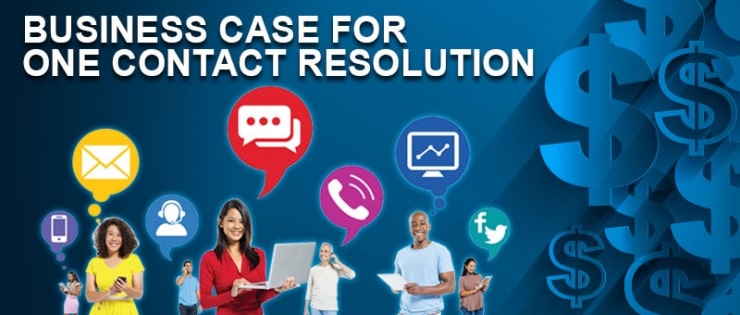
Business Case for One Contact Resolution
When the mission is to deliver world class customer satisfaction on any given contact channel, lower operating costs, increase customer referrals and reduce customer defections - one contact resolution is a must!
Today's connected customers expect to resolve their inquiry or problem on the first contact regardless of what contact channel they choose to use. Customers' expectations to resolve any inquiry or problem using any contact channel they choose is a huge challenge for organizations to meet. In fact, in the vast majority of cases, customers expect to resolve their inquiry or problem in one contact regardless of the contact channel they choose to use or the complexity of the inquiry or problem.
SQM research shows that 93% of customers using the call center channel and 72% of customers using the website channel expect to resolve their inquiry or problem in one contact. Most organizations use internal measurement practices (e.g., repeat contacts, channel completion rates, call center quality assurance) to measure customer channel containment for resolving an inquiry or problem when using a specific contact channel.
While using internal measurements does provide good insights for customer contact channel containment. However, this method cannot determine whether the customer is expected to resolve their inquiry or problem for any given contact channel or, more importantly, if the inquiry or problem was resolved. Therefore, only the Voice of the Customer (VoC) can determine if their inquiry or problem is resolved in one contact and using only one contact channel.
SQM's research also shows that at least 39% of customers who contact an organization use two or more contact channels (e.g., call center, web self-service, IVR self-service, and email) simultaneously to resolve the same inquiry or problem. In addition, 20% of call center calls are because of a self-service channel failure; it is no wonder that resolving their inquiry effortlessly is what customers truly want.
For most customers, resolving an inquiry or problem effortlessly means resolving their selected channel with only one contact. Most contact centers say they are trying to improve the customer experience using a specific contact channel or using multiple contact channels at the same time to resolve an inquiry or problem. However, only a few have succeeded at improving the customer experience for resolving inquiries or issues. Less than 5% of SQM clients can improve One Contact Resolution (OCR) by 5% or more in a specific contact channel from the previous year.
One Contact Resolution
Many customers have experienced contact resolution failures using multiple contact channels to resolve the same inquiry or problem. These failures have substantially negatively impacted customer contact channel satisfaction, operating costs, referrals, and retention.
Therefore, SQM considers OCR measurement an essential practice for delivering world class customer service efficiently and effectively. Put differently, OCR is the metric that measures using only one contact and one channel to resolve an inquiry or problem through a survey to capture the customer's point of view.
One Contact Resolution (OCR) Metric Definition:
OCR is based on customers resolving their inquiry or problem on the first contact and not using another contact channel before or after using the initial contact channel.
The benefits of delivering OCR, from a customer's point of view, are the following:
- Their inquiry or problem is resolved effortlessly; after all, what customers really want is to resolve their inquiry or problem as effortlessly as possible on any channel they choose
- Higher customer satisfaction (Csat) for channel experience because they only had to use one contact and one channel to resolve their inquiry or problem
The benefits of delivering OCR, from an organization's point of view, are the following:
- Channel containment, such that the channel is effective at resolving an inquiry or problem, and therefore other channels are not necessary, resulting in lower operating costs
- OCR provides insights into channel containment from a customer perspective, unlike internal measurements. For example, only the customer can tell the organization if they expected the channel to resolve their inquiry or problem and if their inquiry or problem was actually resolved
- In essence, the OCR metric is a channel containment measure from a customer point of view
- OCR provides insights into the areas of the organization that require improvement
- High OCR performance increases customer referrals and retention
The following figure shows the difference between FCR and OCR performance when a call center was one of the contact channels used. The data reveals that call center first call resolution (FCR) is 70%, and one contact resolution OCR is 59%, which means an alarming 41% of customers had to contact the organization more than once to resolve the same inquiry or problem.
The reason for this difference is that FCR is based on customers resolving their inquiries on the first call and considers only the usage with the call center contact channel. Put differently, FCR does not take into consideration whether or not other contact channels were used. Conversely, OCR factors the customer's ability to resolve their inquiry on the first call and not use another contact channel before or after calling the call center.
In other words, OCR factors in all channels being used to resolve an inquiry or problem and FCR only factors in the call center channel. Therefore, the OCR metric can measure customer experience using a specific contact channel or at the enterprise level to provide an aggregate measure of customer experiences using all contact channels.
Call center FCR and OCR metrics difference
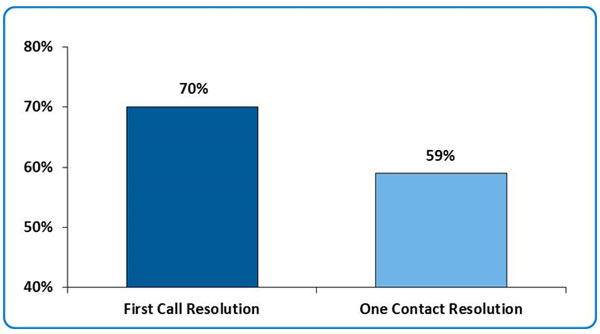
FCR is based on customers resolving their inquiry on the first call and only considers the usage with the call center contact channel being used.
OCR is based on customers resolving their inquiry on the first call and not having to use another contact channel prior to, or after, calling the call center.
Given that only 59% of customers have an OCR experience, it should be viewed as a huge wake-up call for the contact center industry to start measuring the customer’s entire experience (i.e., all contact channels used) when trying to resolve the same inquiry or problem. SQM truly believes that of all the contact center metrics, FCR and OCR are the metrics that matter the most, which is the reason why SQM focuses on both FCR and OCR.
One Contact Resolution Metric Business Case

Improve Customer Satisfaction
The below figure shows that when a customer has to use multiple contact channels to resolve the same inquiry or problem, Csat (very satisfied top box response) is 49%, which is at the fourth quartile level. When the customer experiences OCR, Csat is 89%, which is world class level performance for Csat.
The Csat difference between customers who use multiple channels to resolve their inquiry or problem versus customers who experience OCR is 40%. Clearly, there is a significant Csat penalty when the customer has to use more than one contact channel to resolve the same inquiry or problem. In addition, most customers do not differentiate between high-complexity and low-complexity calls; they expect their issue to be resolved in one contact using only one channel. Clearly, OCR is a driver for improving customer satisfaction.
OCR and multiple channel resolution Csat difference
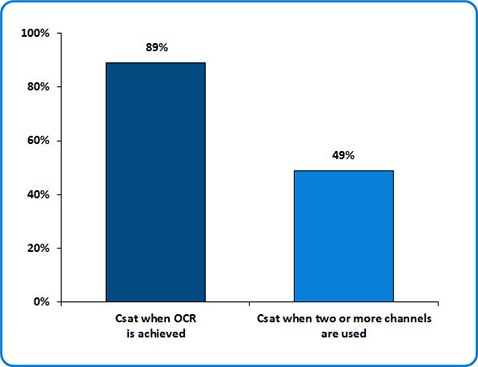

Lower Operating Costs
The below figure shows the opportunity to deflect inbound calls for the call center. SQM’s research shows that 20% of customers who used a call center did so because of a channel failure to resolve their inquiry or problem. Of those customers that used multiple contact channels in order to resolve their inquiry or problem, 88% used a self-service channel (e.g., website, IVR, or mobile) resulting in 18% of total customers. Also, SQM’s research shows that of the 80% of customers who used only the call center contact channel, 13% of those customers prefer self-service contact channels, resulting in 10% of total customers. The key finding from SQM’s research shows that the call center average for the opportunity to deflect inbound calls is 28%. Many customers are not aware of, or do not know, how to use an organization’s self-service contact channels to resolve their inquiry or problem. Interesting, the call center channel represents the biggest opportunity of all channels to lower operating costs because 30% of customers do not experience FCR. Clearly, improving OCR for self-service channels so customers do not have to use the call center channel and improving FCR in the call center so customers do not have to call back represents great opportunities for lower operating costs.
Opportunity to deflect inbound calls
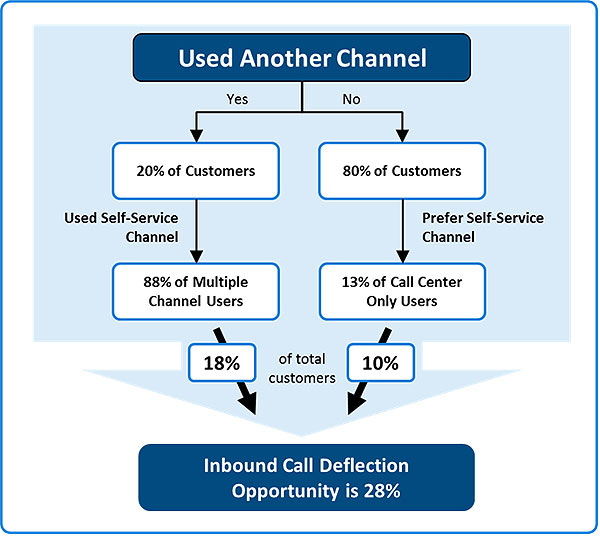
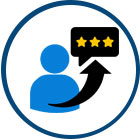
Increase Customer Referrals
Many organizations use a Net Promoter Score (NPS®) which is based on asking the question, “How likely are you to recommend XYZ Company to a friend or colleague?” The customers rank how likely they are to recommend the company using a scale of 0 to 10. Their responses are categorized into three groups: Promoters (those who answered 9 and 10), Passives (those who answered 7 and 8), and Detractors (those who answered 0 to 6).
The company’s NPS® is then calculated as the percentage of Promoters minus the percentage of Detractors. Using this measurement allows organizations to track these groups and get a clear picture of the organization’s performance through their customers’ eyes.
Many customers judge the organization and their willingness to recommend them based on their experience using a contact channel or multiple contact channels to resolve their inquiry or problem. The below data shows the impact that an OCR and non-OCR customer experience has on NPS®.
The data reveals that when customers experience OCR the NPS® is 49%. In general, a good rule of thumb is that an NPS® of 50% or higher is considered to be excellent. When an inquiry or problem was a non-OCR contact resolution (e.g., took 2 or more contacts to resolve) the NPS® drops to 36%. Most alarming is the -29% NPS® when an inquiry or problem contact goes unresolved. Clearly, OCR is a driver for improving your NPS®.
One Contact Resolution (OCR) impact on NPS®
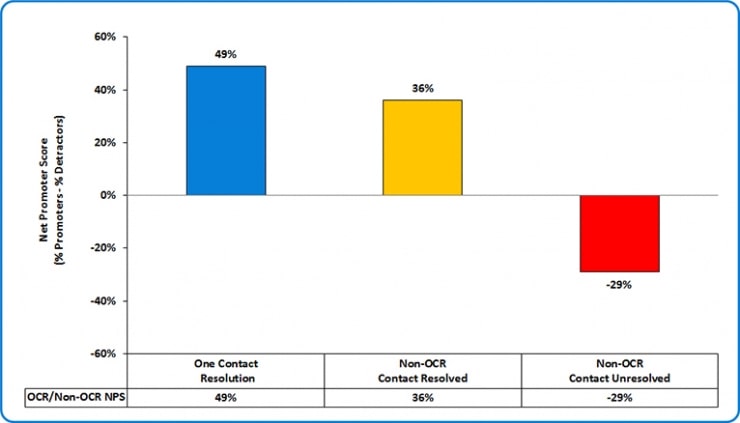
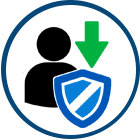
Reduce Customer Defections
The below figure shows that of the customers whose contact was resolved in one contact using only one channel, in other words OCR, only 1% expressed their intent not to continue using the organization’s products and services as a result of their contact channel experience.
When the issue was unresolved, 23% of customers expressed their intent not to continue using the organization’s products and services because of their contact channel experience. The cost of these customer defections tends not to be understood by contact centers because it is not often measured.
For many contact centers, retaining customers represents the biggest opportunity to add true value to their organization. Resolving issues, preferably in one contact and using only one channel, is the key to reducing customer defections. Clearly, when a customer uses a contact channel it is essential to provide OCR in order to reduce customer defections.
Contact resolution impact on customer defections
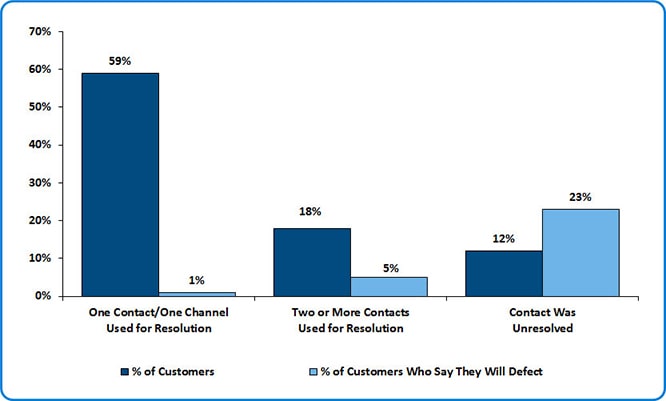
In closing, most C-level executives would agree that delivering a world class customer experience for contact channel usage is critical to their organization's success. As a result, many organizations strive to have a consistent customer experience for all their contact channels.
Yet, very few organizations can say, from a VoC perspective, that they provide a consistent experience or world class service to their customers across all the contact channels. Again, companies strive to have a consistent customer experience across all their contact channels because that is what customers expect.
In addition, many North American CEOs seek to improve customer experience, and, in many cases, it is the number one priority for their organization. Yet, very few C-level executives are aware that OCR is essential for delivering a world class Csat, lowering operating costs, increasing customer referral, and reducing customer defections.
We encourage all readers of this paper to start measuring OCR and share it with the C-level executives. If you need any help, give SQM a call, and we will be glad to help you out with this effort.
Quick Related Links
First Call Resolution Definition First Call Resolution PPT First Call Resolution Benefits
First Call Resolution Strategies First Call Resolution Operating Philosophy First Call Resolution Formula Calculate First Call Resolution Rate What Is a Good FCR Rate? One Contact Resolution Channel Hopping
